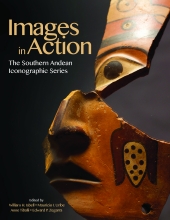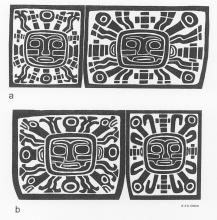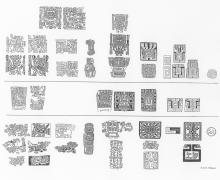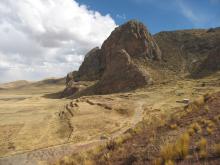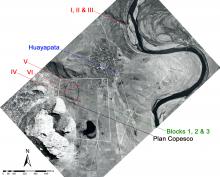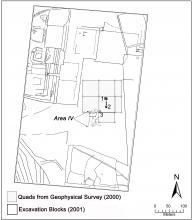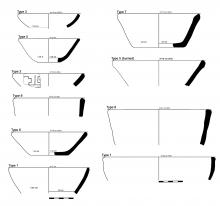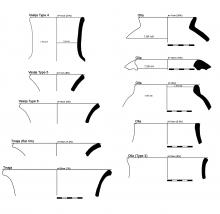Visual database
Panels corresponding to Groups A and B of several Pucara-style rectangular and double-chambered stone vessels. The fragments were excavated by Alfred Kidder II at the semi-subterranean temple of Pucara. Drawn by Stanislava Chávez on the basis of rubbings by Karen and Sergio Chávez.
Rollout drawing of the Woman with Alpaca theme portrayed on Pucara-style polychrome and incised pottery vessels excavated at the Pucara temple complex. Note the small version of the Rayed Head Motif under the alpaca. Reconstructed by Stanislava Chávez based on drawings by Sergio Chávez of several glued fragments pertaining to two similar versions of the same theme on pedestal-based bowls.
Rollout drawing of the Feline Man theme portrayed on Pucara-style polychrome and incised pottery vessels excavated at the Pucara temple complex. Reconstructed by Stanislava Chávez on the basis of drawings by Sergio Chávez of several glued fragments pertaining to two similar versions of the same theme on pedestal-based bowls.
Continuities in a selection of Yaya-Mama style iconography as it develops into "Classic" Tiahuanaco style. The lower portion represents "early" and "late" Yaya-Mama motifs and designs in pottery and stone; the middle shows examples of "transitional" images depicted on snuff tablets, Provincial Pucara textiles, and stone carvings; the upper portion represents motifs and designs from the Gateway of the Kalasasaya, the Bennett, Ponce, and Kochamama stelae, including two examples of statues known as chachapuma. The two motifs on the upper left derive from a Huari tapestry published by Isbell and Knobloch (2009:Figure 5). Line drawings by Sergio Chávez.
Map locating Pukara in the northwestern Lake Titicaca Basin. Also shown are select sites of the Late Formative Period.
Peñon of Pukara and the Qalasaya complex. Photo by Matthew S. Wilhelm, 2006.
Air photo with areas of previous research at Pukara: Kidder 1939 excavations are marked in red; the multiple excavations at Huayapata are marked in blue; the general area of the Plan COPESCO excavations on the Qalasaya are marked in black; and the 2000-2001 fieldwork is marked in green (air photo from SAN, Peru). The limits of the site core are indicated in white.
Map of the central ceremonial district with areas indicated from the geophysical survey (2000), recent excavations (2001), and Kidder's Area IV excavation (1939) on the Central Pampa.
Unrestricted vessels (bowl types 1-9).
Restricted vessels (selected examples of vasijas, ollas, and tinajas).
